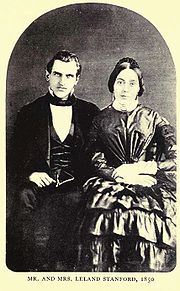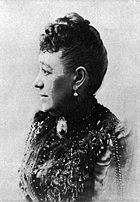
Jane Stanford
Encyclopedia


Stanford University
The Leland Stanford Junior University, commonly referred to as Stanford University or Stanford, is a private research university on an campus located near Palo Alto, California. It is situated in the northwestern Santa Clara Valley on the San Francisco Peninsula, approximately northwest of San...
with her husband, Leland Stanford
Leland Stanford
Amasa Leland Stanford was an American tycoon, industrialist, robber baron, politician and founder of Stanford University.-Early years:...
, whom she wed in 1850. She was the daughter of a shopkeeper and lived on Washington Avenue in Albany, New York, before her marriage. She and her husband headed west, first to Wisconsin
Wisconsin
Wisconsin is a U.S. state located in the north-central United States and is part of the Midwest. It is bordered by Minnesota to the west, Iowa to the southwest, Illinois to the south, Lake Michigan to the east, Michigan to the northeast, and Lake Superior to the north. Wisconsin's capital is...
and then to California
California
California is a state located on the West Coast of the United States. It is by far the most populous U.S. state, and the third-largest by land area...
.
Early life and marriage
Born Jane Eliza Lathrop in Albany, New YorkAlbany, New York
Albany is the capital city of the U.S. state of New York, the seat of Albany County, and the central city of New York's Capital District. Roughly north of New York City, Albany sits on the west bank of the Hudson River, about south of its confluence with the Mohawk River...
, she was the daughter of Dyer and Jane Anne (Shields) Lathrop. She attended The Albany Academy for Girls, the longest running girls day school in the country. She married Leland Stanford
Leland Stanford
Amasa Leland Stanford was an American tycoon, industrialist, robber baron, politician and founder of Stanford University.-Early years:...
on September 30, 1850, and went to live with him in Port Washington, Wisconsin
Port Washington, Wisconsin
Port Washington is the county seat of Ozaukee County in the U.S. state of Wisconsin. The city is about 25 miles north of Milwaukee and 110 miles north of Chicago. In the 2000 census Port Washington had a population of 10,467...
, where he had practiced law since 1848.
The Stanfords lived in Port Washington until 1852 when, after his law library and other property had been lost to fire, they returned to Albany. Stanford then went to California to join his brothers in mercantile business while Jane remained in Albany with her family. He returned in 1855, and the following year they moved to San Francisco, where he engaged in mercantile pursuits on a large scale.
Stanford was a co-founder of the Central Pacific Railroad
Central Pacific Railroad
The Central Pacific Railroad is the former name of the railroad network built between California and Utah, USA that formed part of the "First Transcontinental Railroad" in North America. It is now part of the Union Pacific Railroad. Many 19th century national proposals to build a transcontinental...
, serving as its president from 1861 until his death in 1893. He was also president of the Southern Pacific Railroad
Southern Pacific Railroad
The Southern Pacific Transportation Company , earlier Southern Pacific Railroad and Southern Pacific Company, and usually simply called the Southern Pacific or Espee, was an American railroad....
from 1868 until ousted from the post by Collis Potter Huntington in 1890.
Stanford University
Upon the death of their only son Leland Stanford, Jr.Leland Stanford, Jr.
Leland Stanford Jr. , Leland DeWitt Stanford until age nine, was the only child of Governor Leland Stanford of California and his wife Jane Stanford née Lathrop, and is the namesake of Stanford University in Palo Alto, California, United States.Leland Jr...
, in 1884 while on a trip in Italy
Italy
Italy , officially the Italian Republic languages]] under the European Charter for Regional or Minority Languages. In each of these, Italy's official name is as follows:;;;;;;;;), is a unitary parliamentary republic in South-Central Europe. To the north it borders France, Switzerland, Austria and...
, the elder Leland turned to his wife, Jane, and said, "The children of California shall be our children." They then founded Leland Stanford Junior University in their son's honor. After Leland's death on June 21, 1893, Jane in effect took control of the University and it was at her direction that Stanford University gained an early focus on the arts. She also advocated the admission of women.
Jane Stanford figured prominently in the issue of academic freedom when she sought and ultimately succeeded in having Stanford University economist Edward A. Ross
Edward A. Ross
Edward Alsworth Ross was a progressive American sociologist, eugenicist, and major figure of early criminology.-Biography:...
fired for making speeches favoring Democrat William Jennings Bryan
William Jennings Bryan
William Jennings Bryan was an American politician in the late-19th and early-20th centuries. He was a dominant force in the liberal wing of the Democratic Party, standing three times as its candidate for President of the United States...
and favoring racism against Chinese American "coolies", outlining eugenics policies directed against Chinese people and other racial groups, and for his collectivist economic teachings. This resulted in the American Association of University Professors
American Association of University Professors
The American Association of University Professors is an organization of professors and other academics in the United States. AAUP membership is about 47,000, with over 500 local campus chapters and 39 state organizations...
' "Report on Academic Freedom and Tenure" of 1915, by Arthur Oncken Lovejoy
Arthur Oncken Lovejoy
Arthur Oncken Lovejoy was an influential American philosopher and intellectual historian, who founded the field known as the history of ideas....
and Edwin R. A. Seligman, and in the AAUP 1915 Declaration of Principles.
Later life
She made her famous "jewel journey" to London, England during 1897, the year of Queen Victoria's Diamond JubileeDiamond Jubilee
A Diamond Jubilee is a celebration held to mark a 60th anniversary in the case of a person or a 75th anniversary in the case of an event.- Thailand :...
to dispose of her collection of jewels to raise funds for her University, but she was not able to sell her storied ruby collection. Historian Oscar Lewis said that the Queen, from her carriage, nodded to Stanford, who was watching the parade from a rented window on Fleet Street
Fleet Street
Fleet Street is a street in central London, United Kingdom, named after the River Fleet, a stream that now flows underground. It was the home of the British press until the 1980s...
.
In the late 1890s, Jane Stanford attempted to reconcile her differences with Huntington at his office in New York. "Mr. Huntington", she said, "I have come to make my peace with you." "Well, I declare", was his surprised reaction.
Death
In 1905, Jane Stanford was at the center of one of America's legendary mysteries. She allegedly died of strychnine poisoningStrychnine poisoning
Strychnine poisoning can be fatal to humans and other animals and can occur by inhalation, swallowing or absorption through eyes or mouth. It produces some of the most dramatic and painful symptoms of any known toxic reaction...
while on the island of Oahu
Oahu
Oahu or Oahu , known as "The Gathering Place", is the third largest of the Hawaiian Islands and most populous of the islands in the U.S. state of Hawaii. The state capital Honolulu is located on the southeast coast...
, in a room at the Moana Hotel
Moana Hotel
The Moana Hotel, also known as the First Lady of Waikīkī, is a famous historic hotel on the island of Oahu, located at 2365 Kalākaua Avenue in Honolulu, Hawaii. Built in the late 19th century as the first hotel in Waikiki, the Moana opened its doors to guests in 1901, becoming the first large hotel...
.
On January 14, 1905 Stanford had consumed mineral water at her mansion in San Francisco which had tasted bitter. She had promptly vomited the water up and, when both her maid and secretary had agreed that the bottled water tasted odd, had sent it to a pharmacy for analysis. The result, returned a few weeks later, was that the water had been poisoned with strychnine. Shortly thereafter Stanford decided to sail to Hawaii, partly to rest and recuperate from a cold. The Stanford party left San Francisco for Honolulu on February 15, 1905.
At the Moana Hotel
Moana Hotel
The Moana Hotel, also known as the First Lady of Waikīkī, is a famous historic hotel on the island of Oahu, located at 2365 Kalākaua Avenue in Honolulu, Hawaii. Built in the late 19th century as the first hotel in Waikiki, the Moana opened its doors to guests in 1901, becoming the first large hotel...
on the evening of February 28, Stanford asked for bicarbonate of soda
Sodium bicarbonate
Sodium bicarbonate or sodium hydrogen carbonate is the chemical compound with the formula Na HCO3. Sodium bicarbonate is a white solid that is crystalline but often appears as a fine powder. It has a slightly salty, alkaline taste resembling that of washing soda . The natural mineral form is...
to settle her stomach. Her personal secretary, Bertha Berner, prepared the solution, which Stanford drank. At 11:15 p.m., Stanford cried out for her servants and hotel staff to call for a physician, feeling that she had lost sensation in her body. Robert Cutler, author of "The Mysterious Death of Jane Stanford", recounted what took place upon the arrival of Dr. Francis Howard Humphris, the hotel physician:
- "As Humphris tried to administer a solution of bromine and chloral hydrate, Mrs. Stanford, now in anguish, exclaimed, 'My jaws are stiff. This is a horrible death to die.' Whereupon she was seized by a tetanic spasm that progressed relentlessly to a state of severe rigidity: her jaws clamped shut, her thighs opened widely, her feet twisted inwards, her fingers and thumbs clenched into tight fists, and her head drew back. Finally, her respiration ceased. Stanford was dead from strychnine poisoning."
Controversy resulted from the quick verdict of the coroner's jury, which reached its conclusion in less than two minutes. A dispatch in The New York Times of March 11, 1905, stated that the verdict was "written out with the knowledge and assistance of Deputy High Sheriff Rawlins", implying that the jurors may have been coached on what conclusion to reach. This controversy was largely stoked by Stanford University President David Starr Jordan
David Starr Jordan
David Starr Jordan, Ph.D., LL.D. was a leading eugenicist, ichthyologist, educator and peace activist. He was president of Indiana University and Stanford University.-Early life and education:...
. Jordan had sailed to Hawaii himself and hired a local doctor, Ernest Coniston Waterhouse, to dispute poisoning as the cause of death. He subsequently reported to the press that Stanford had in fact died of heart failure. Jordan's motives for involvement in the case are unknown, however, in his book, Cutler concludes that “There is ample evidence that Mrs. Stanford was poisoned, that she was given good care, and that Jordan went over there to hush it up.”.
The source of the strychnine was never identified. Today, the room no longer exists, having been incorporated in an expansion of the hotel lobby. Stanford was buried alongside her husband Leland and their son at the Stanford family mausoleum
Stanford Mausoleum
The Stanford Mausoleum, located in the northwest of the Stanford University campus in the Stanford University Arboretum, holds the remains of the university's namesake Leland Stanford, Jr...
on the Stanford campus.
External links
- Jane Stanford--Jane Stanford's 1898 Time Capsule
- Stanford Magazine--"Who Killed Jane Stanford?"
- "President Bollinger Delivers Cardozo Lecture on Academic Freedom - 2005, Columbia U.
- "The roots/routes of academic freedom and the role of the intellectual" --William G. Tierney, American Association of University Professors
- "American Association of University Professors' 1915 Declaration of Principles"

